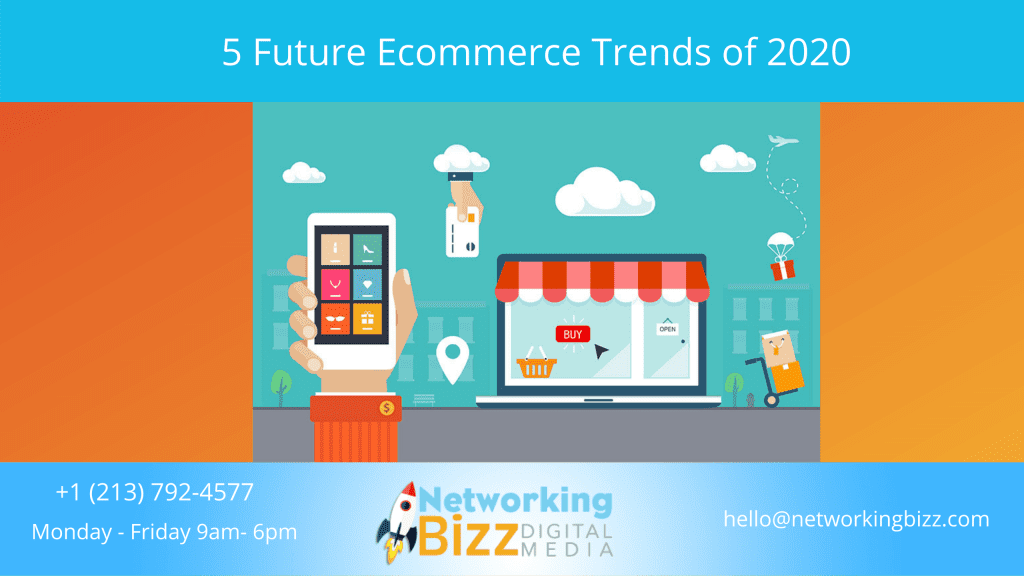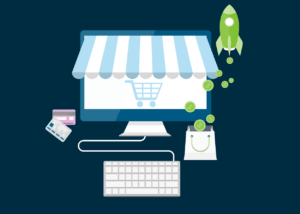
Is your business joining the ecommerce revolution? If not, you could be missing out on the projected $4.8 trillion in retail ecommerce sales projected worldwide for 2021.
Companies embracing ecommerce marketing strategies are experiencing rapid growth. In 2017, there were 1.66 billion online buyers. This number is expected to skyrocket to 2.14 billion by 2021.
Prepare for the exciting future of ecommerce by implementing the emerging trends of 2020.
1. Personalization and Customer Engagement
 Compared to traditional retail shopping, ecommerce stores lack face-to-face personal interaction. Online stores do not have a retail clerk who can recommend products based on your interests, tastes, and preferences.
Compared to traditional retail shopping, ecommerce stores lack face-to-face personal interaction. Online stores do not have a retail clerk who can recommend products based on your interests, tastes, and preferences.
To mimic this experience, ecommerce companies leverage personalization opportunities throughout the shopping journey. Much like online course providers are replacing the need for in-person teaching, ecommerce is replacing the need for in-store retail experiences.
Using personal online data such as search queries, page visits, and purchase history, brands transform their online stores to best serve the customer’s needs and interests. For instance, login to your Amazon account. You’ll find recommended products based on your past purchases, ads tailored to your search history, and marketing copy speaking directly to you. Expect more brands to follow suit as personalization technology becomes easier to integrate into ecommerce sites.
Much like personalized emails generate 6x higher transaction rates and convert better than cold emails, consumers spend 48% more when their experience is personalized. In an age where privacy is key, studies also showed 57 percent of online shoppers are comfortable with providing personal information to a brand, as long as it directly benefits their shopping experience.
Connecting your online store to a CRM like HubSpot will allow you to use your customer’s purchase and website behavior to personalize your marketing, emails, and even pages for abandoned cart nurturing, as well as upsell campaigns.
2. AI, Assistants, and Chatbots
 AI assistants can handle a number of tasks typically assigned to a human, such as managing inventory or handling inquiries. These digital assistants carry out various processes, freeing up time for you to focus on other aspects of running the business.
AI assistants can handle a number of tasks typically assigned to a human, such as managing inventory or handling inquiries. These digital assistants carry out various processes, freeing up time for you to focus on other aspects of running the business.
For instance, chatbots can fulfill a number of customer service needs, from answering questions about a product to discussing a complaint. AI and chatbots also learn from customer conversations and evolve to better assist in a user’s personalized ecommerce experience.
As reported in a 2017 Statista study, 34 percent of respondents stated they would be comfortable getting answers to their questions from AI, such as a chatbot or virtual assistant, when shopping. You can easily get started yourself. Many tools like HubSpot’s Chatbot Builder allow you to create your own bot for free.
3. B2B Ecommerce Is Exploding
 Who said ecommerce was only for B2C brands? B2B companies are leveraging upcoming ecommerce trends, too. It’s even been projected that B2B ecommerce sales will increase worldwide to $6.6 trillion by the end of 2020.
Who said ecommerce was only for B2C brands? B2B companies are leveraging upcoming ecommerce trends, too. It’s even been projected that B2B ecommerce sales will increase worldwide to $6.6 trillion by the end of 2020.
In a survey of 500 B2B organizations, BigCommerce found that 80 percent accepted orders and payment via their website, further proving the growth of ecommerce in B2B industries moving forward.
Ecommerce personalization works wonders for B2B shoppers as well. Research found that 50 percent of B2B buyers desired personalization when searching for online suppliers with whom to build relationships.
4. Interactive Product Visualization
 We’ve all hesitated to hit the “Buy” button when shopping online. Before you enter your payment info, you begin to wonder:
We’ve all hesitated to hit the “Buy” button when shopping online. Before you enter your payment info, you begin to wonder:
“Is this product going to be exactly what I need?”
“Is this a quality product? Or, is this a knock-off?”
As a result, we have a strong need to interact with a product before we commit to a purchase. Online reviews and influencer trends aren’t enough. We want to see the product, feel it, hold it in our hands, and remove all feelings of doubt before purchasing.
While we were once satisfied with high-quality images of products, today’s technology lets us use virtual reality, 3D imaging, augmented reality, and more to interact with a product from the comfort of our laptop or smartphone.
Even ecommerce product videos have evolved to be more engaging. What was once a cheesy infomercial has transformed into an immersive, 360-degree online shopping experience.
Interactive product visualization technology seeks to bring the tangible in-store experience to online consumers and alleviate their hesitation prior to purchasing.
Converse, for example, offers customers the ability to customize their shoes online. During this process, users build their own design through turning, flipping, and zooming in on the shoe.
Prior to submitting their order, customers have full confidence they’ve built the exact shoes they desire thanks to the interactive nature of the process.
5. More Custom Retail Experiences
 Did you think ecommerce was killing brick and mortar stores? If so, think again.
Did you think ecommerce was killing brick and mortar stores? If so, think again.
While many big-box stores are in fact going bankrupt, retail experiences aren’t going away – they’re just adapting to a new reality. Remember that in-person, physical product experience we just discussed? While interactive product technology, personalization, and chatbots all work to replicate that feeling online, no technology can truly replace every detail of an in-store experience.
With this in mind, brands are creating immersive retail experiences to further drive sales, hire more sales reps, and develop lasting customer relationships. For instance, Amazon is launching stores, named “4-Star,” throughout the United States. At these stores, you can interact with Amazon’s devices and top products in person. Other brands profiting from this new reality are brick and click stores, which combine a unified retail and ecommerce experience. These brands open retail stores with less square footage and employees, but a more personalized and interactive in-store visit.
With plenty of hosting providers to choose from and ecommerce platforms on the rise, companies are creating ecommerce experiences within a retail store via digital kiosks. As a user engages with the kiosk, it can perform a number of functions including providing personalized product suggestions or displaying interactive information about the product at hand.

